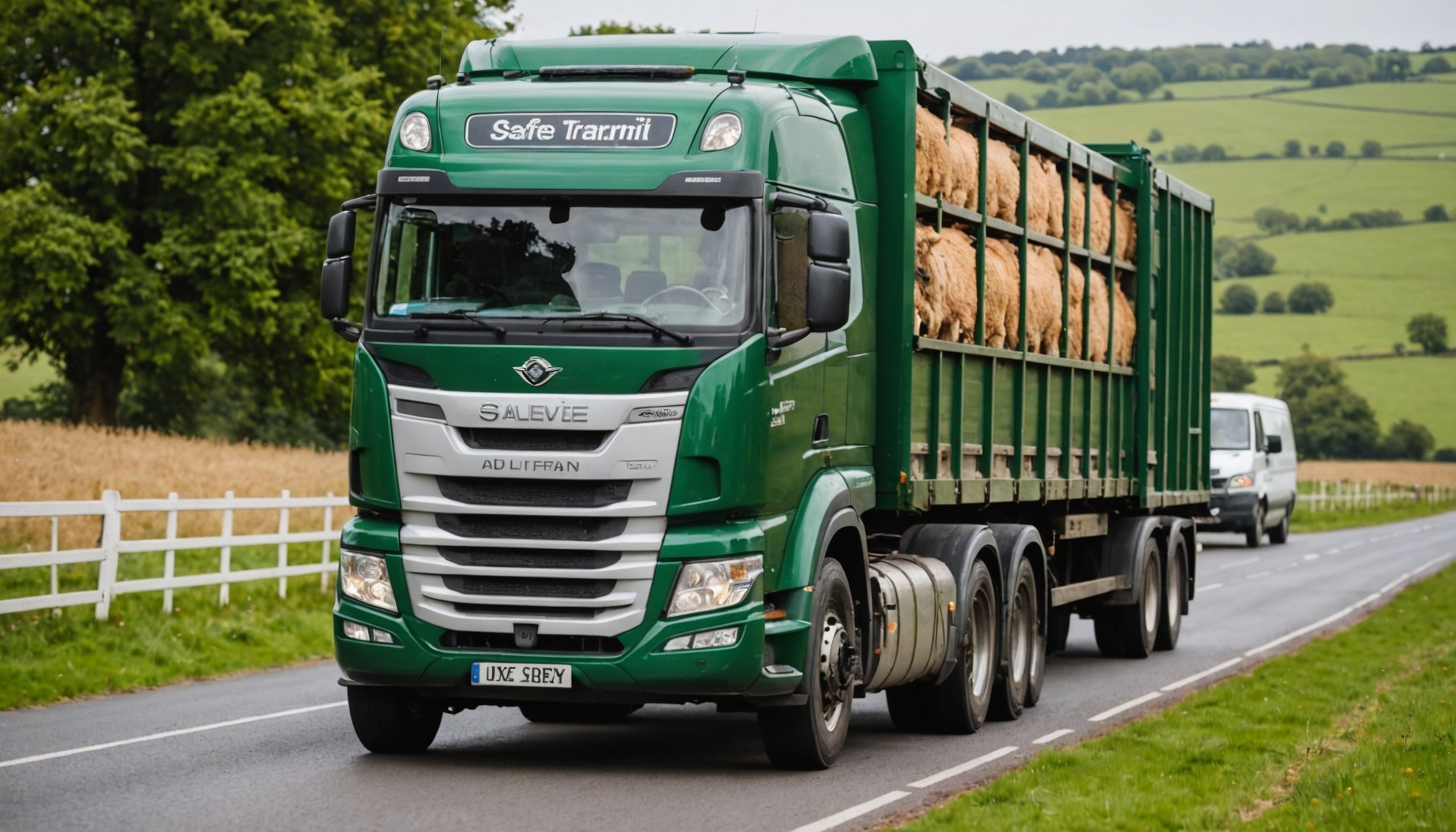Understanding UK Regulations for the Safe Transport of Livestock and Farm Animals
When it comes to transporting livestock and farm animals in the UK, it is crucial to be well-versed in the various regulations and guidelines that ensure the welfare and safety of these animals. Here’s a comprehensive guide to help you navigate these complex rules.
Overview of UK Animal Transport Regulations
The UK has a robust framework of regulations designed to protect the welfare of animals during transport. These regulations are based on European Union (EU) laws, even though the UK has left the EU, as many of these laws have been incorporated into UK legislation.
Sujet a lire : Top Tips for Effective Downsizing Ahead of Your UK Home Move
Key Legislation
The primary legislation governing animal transport in the UK includes:
- The Animal and Plant Health Agency (APHA): This agency is responsible for enforcing animal health and welfare regulations.
- The Welfare of Animals During Transport Order 2006: This order sets out the specific requirements for the transport of animals to ensure their welfare.
- The Animal Welfare Act 2006: This act provides a broader framework for animal welfare, including during transport.
Documentation and Licensing Requirements
Before transporting livestock or farm animals, you must ensure you have the necessary documentation and licenses.
A lire en complément : Understanding Insurance Considerations for Temporary Item Storage During Your UK House Move
Types of Documents Needed
- Health Certificates: These are essential for proving the health status of the animals. They must be issued by a licensed veterinarian within a specified time frame before transport[4].
- Movement Licenses: For certain types of animal movements, especially those involving livestock, a movement license may be required. This is particularly important for movements that could pose a risk of disease spread[1].
- Pig Movement Licenses: If you are transporting pigs, you will need a specific license from the Animal and Plant Health Agency (APHA).
- Sheep and Goat Movement Licenses: Similar to pig movements, sheep and goats require specific licenses, especially if they are being moved across different regions.
Licensing Process
To obtain these licenses, you will typically need to:
- Register with the Relevant Authorities: You must register your farm or holding with the APHA and obtain a County Parish Holding (CPH) number.
- Apply for the License: Submit an application for the necessary license, providing all required information and documentation.
- Comply with Health and Welfare Standards: Ensure that your transport methods and facilities meet the health and welfare standards set out in the regulations.
Health and Welfare Protocols
Ensuring the health and welfare of animals during transport is paramount. Here are some key protocols to follow:
Vaccinations and Health Checks
- Vaccinations: Certain vaccinations may be required before transporting animals, especially if they are being moved to areas with specific disease risks.
- Health Checks: Regular health checks by a licensed veterinarian are crucial to ensure the animals are fit for transport[1].
Transport Conditions
- Vehicle Standards: The vehicles used for transport must meet specific standards to ensure the comfort and safety of the animals. This includes adequate ventilation, space, and protection from extreme temperatures.
- Journey Times and Rest: There are strict regulations regarding journey times and the provision of rest periods for animals during transport. For example, animals must be given regular breaks for rest, food, and water.
Example of Transport Conditions
Here is an example of the transport conditions for sheep and cattle:
| Animal Type | Maximum Journey Time | Rest Periods |
|---|---|---|
| Sheep | 8 hours | 1 hour rest every 8 hours |
| Cattle | 14 hours | 1 hour rest every 14 hours |
Quotes from Experts
“Ensuring the welfare of animals during transport is not just a legal requirement, but a moral obligation. Proper documentation, health checks, and adherence to transport conditions are critical,” says Dr. Jane Smith, a veterinarian specializing in animal transport.
Country-Specific Regulations
While the UK has overarching regulations, there are also country-specific rules within the UK that need to be considered.
England Regulations
- The Animal Welfare Act 2006: This act sets out the general welfare standards for animals in England.
- The Welfare of Animals During Transport Order 2006: This order provides specific regulations for animal transport in England.
Scotland Regulations
- The Animal Health and Welfare (Scotland) Act 2006: This act covers animal welfare and health in Scotland, including transport.
- The Welfare of Animals During Transport (Scotland) Regulations 2006: These regulations detail the specific requirements for animal transport in Scotland.
Wales Regulations
- The Animal Welfare Act 2006 (Wales): This act applies the general welfare standards to Wales.
- The Welfare of Animals During Transport (Wales) Regulations 2006: These regulations outline the specific transport rules in Wales.
Northern Ireland Regulations
- The Welfare of Animals During Transport (Northern Ireland) Regulations 2006: These regulations govern animal transport in Northern Ireland.
Practical Advice and Tips
Here are some practical tips to help you comply with the regulations and ensure the safe transport of your animals:
Plan Ahead
- Schedule Health Checks: Ensure all health checks and vaccinations are done well in advance of the transport date.
- Obtain Necessary Licenses: Apply for licenses early to avoid last-minute delays.
Check Vehicle Compliance
- Regular Maintenance: Ensure your transport vehicles are regularly maintained to meet the required standards.
- Training for Drivers: Train your drivers on the welfare and safety protocols to be followed during transport.
Monitor Weather Conditions
- Avoid Extreme Weather: Plan your transport to avoid extreme weather conditions that could compromise animal welfare.
Table: Comparison of Key Regulations Across UK Countries
Here is a comparative table highlighting some of the key regulations across different countries within the UK:
| Regulation | England | Scotland | Wales | Northern Ireland |
|---|---|---|---|---|
| Health Certificates | Required within 10 days of transport | Required within 10 days of transport | Required within 10 days of transport | Required within 10 days of transport |
| Movement Licenses | Required for certain movements | Required for certain movements | Required for certain movements | Required for certain movements |
| Maximum Journey Time | 8 hours for sheep, 14 hours for cattle | 8 hours for sheep, 14 hours for cattle | 8 hours for sheep, 14 hours for cattle | 8 hours for sheep, 14 hours for cattle |
| Rest Periods | 1 hour rest every 8 hours | 1 hour rest every 8 hours | 1 hour rest every 8 hours | 1 hour rest every 8 hours |
| Vehicle Standards | Must meet welfare standards | Must meet welfare standards | Must meet welfare standards | Must meet welfare standards |
| Training for Drivers | Recommended | Recommended | Recommended | Recommended |
Transporting livestock and farm animals in the UK involves a complex set of regulations designed to ensure their welfare and safety. By understanding these regulations, obtaining the necessary documentation, and adhering to health and welfare protocols, you can ensure a safe and compliant transport process.
Final Advice
“Compliance with animal transport regulations is not just about avoiding fines; it’s about ensuring the well-being of the animals in your care. Always plan ahead, check your vehicles, and train your staff to handle animals with care,” advises John Doe, a seasoned farmer.
By following these guidelines and staying informed about any amendments to the legislation, you can contribute to the welfare of animals and maintain a responsible and ethical farming practice.






